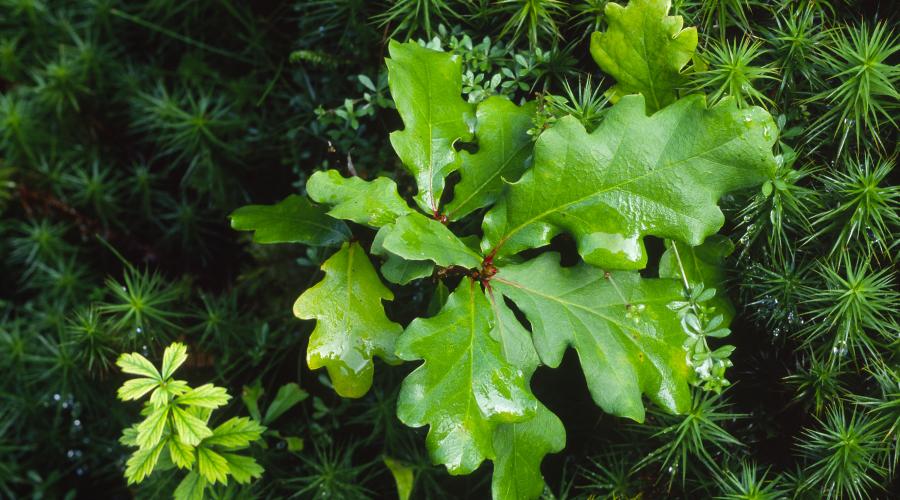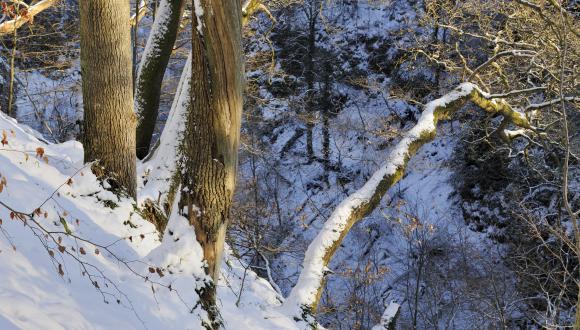
Native versus non-native woodland
Our native trees and shrubs are valuable, as they provide much of our native wildlife with its natural habitats.
Native woodland
Native tree species are those that became established in the British Isles after the most recent glacial period, around 11,000 years ago. Native woodland is descended directly from these trees.
Native tree and shrub species provide much of our native wildlife with its natural habitats, so are a valuable part of Britain’s nature and landscapes. This is why we seek to maintain the native trees and shrubs in our woods.
Some native tree and shrub species are linked to a huge number and range of wildlife. Other, less bountiful species are home to specialised flora and fauna. Tree and shrub species that grow in places where they’d naturally occur are usually of the greatest value to nature conservation.
Introduced species
Some tree species were natural colonists of the British Isles, while humans introduced other species.
It’s likely that many species were introduced to Britain on many occasions. But British woodland cover today is fragmented and tree planting has increased, so the natural distribution of tree species is hidden. It’s very difficult now to predict their natural biogeography.
Read about the history of Scotland’s woodlands.
Tree planting
The UK Forestry Standard recommends using plants of local provenance, preferably from semi-natural parent trees, when planting in semi-natural woodlands or to create native woodlands. Provenance refers to the stand from which the seed was collected.
The UK Woodland Assurance Standard also seeks the use of seed of local origin – i.e. the natural range from which the seed originally derived – to restock and plant semi-natural woodlands.
The Forestry Commission has developed a system to help with the sourcing of local stock for planting native tree and shrub species. Find out more in the Using Local Stock for Planting Native Trees and Shrubs practice note.
Non-native trees
Non-native trees can alter the character and species composition of the woods in which they occur. They may increase the potential richness of woodland. Or their impact may be negative if the trees cast too much shade or their leaf litter smothers the development of the field layer.
The value of each non-native species must usually be assessed within the site-specific context of the wood where it occurs. But the negative impact of some species is so universal that a blanket ban is apt.
For example, rhododendron smothers most aspects of native woodland and so should be removed when found within or close to all such sites.
Human influence
Woodland that hasn’t been managed or exploited by man isn’t necessarily free from human influence. Man-made environmental change often occurs at a landscape scale – and even protected forest areas are affected.
Even our definition of nativeness may have to change in future. Most woods show changes in their composition over a stand’s life-cycle. But climate change will noticeably affect the distribution of species in Scotland, with northward movement of species likely. Tree species may thus spread to areas where they aren’t locally native.
Trees and shrubs native to Scotland
| Latin name | Common name |
|---|---|
| Alnus glutinosa | Alder |
| Betula pendula | Silver Birch |
| Betula pubescens | Hairy birch |
| Corylus avellana | Hazel |
| Crataegus monogyna | Hawthorn |
| Cytisus scoparius | Broom |
| Euonymus europaeus | Spindle |
| Fraxinus excelsior | Ash |
| Ilex aquifolium | Holly |
| Juniperus communis | Juniper |
| Malus sylvestris | Crab apple |
| Pinus sylvestris | Scot's pine |
| Populus nigra subsp betulifolia | Black poplar |
| Populus tremula | Aspen |
| Prunus avium | Gean |
| Prunus padus | Bird-cherry |
| Prunus spinosa | Blackthorn |
| Quercus petraea | Sessile oak |
| Quercus robur | Pedunculate oak |
| Ribes rubrum | Red currant |
| Ribes spicatum | Erect-spiked red-currant |
| Rosa caesia | Hairy dog rose |
| Rosa canina agg. | Dog rose |
| Rosa mollis agg. | Soft downy rose |
| Rosa rubiginosa | Sweet briar |
| Rosa sherardii | Sherard's downy rose |
| Rosa tomentosa | Harsh downy rose |
| Rubus idaeus | Raspberry |
| Salix aurita | Eared sallow |
| Salix caprea | Goat willow |
| Salix cinerea | Grey willow |
| Salix myrsinifolia | Dark-leaved willow |
| Salix pentandra | Bay willow |
| Salix phylicifolia | Tea-leaved willow |
| Salix purpurea | Purple osier |
| Sambucus nigra | Elder |
| Sorbus aucuparia | Rowan |
| Taxus baccata | Yew |
| Tilia cordata | Small leaved lime |
| Ulex europaeus | Gorse |
| Ulex gallii | Western gorse |
| Ulmus glabra | Wych elm |
| Vibernum opulus | Guelder rose |
Based on Preston, C. D., Pearman, D. A. & Dines, T. D. 2002. New Atlas of the British and Irish Flora. Oxford: Oxford University Press.
Species list adapted from ‘Origin and distribution of hedgerow species’, by Heather Robertson, English Nature, 13.06.06
Published: 2011




